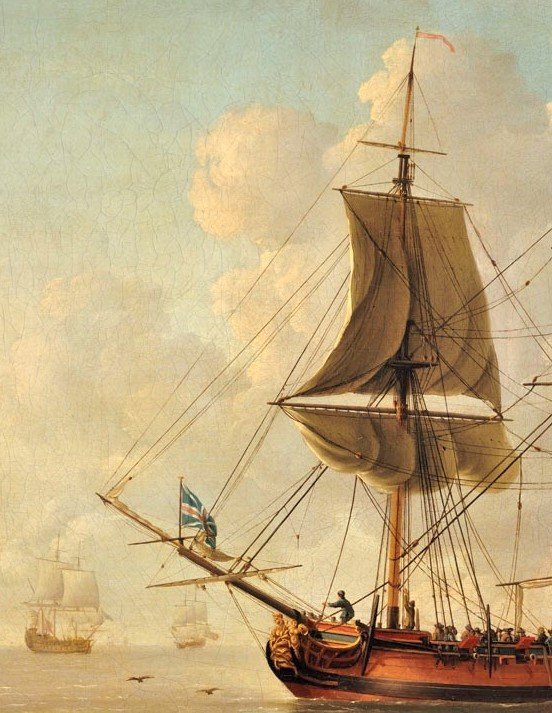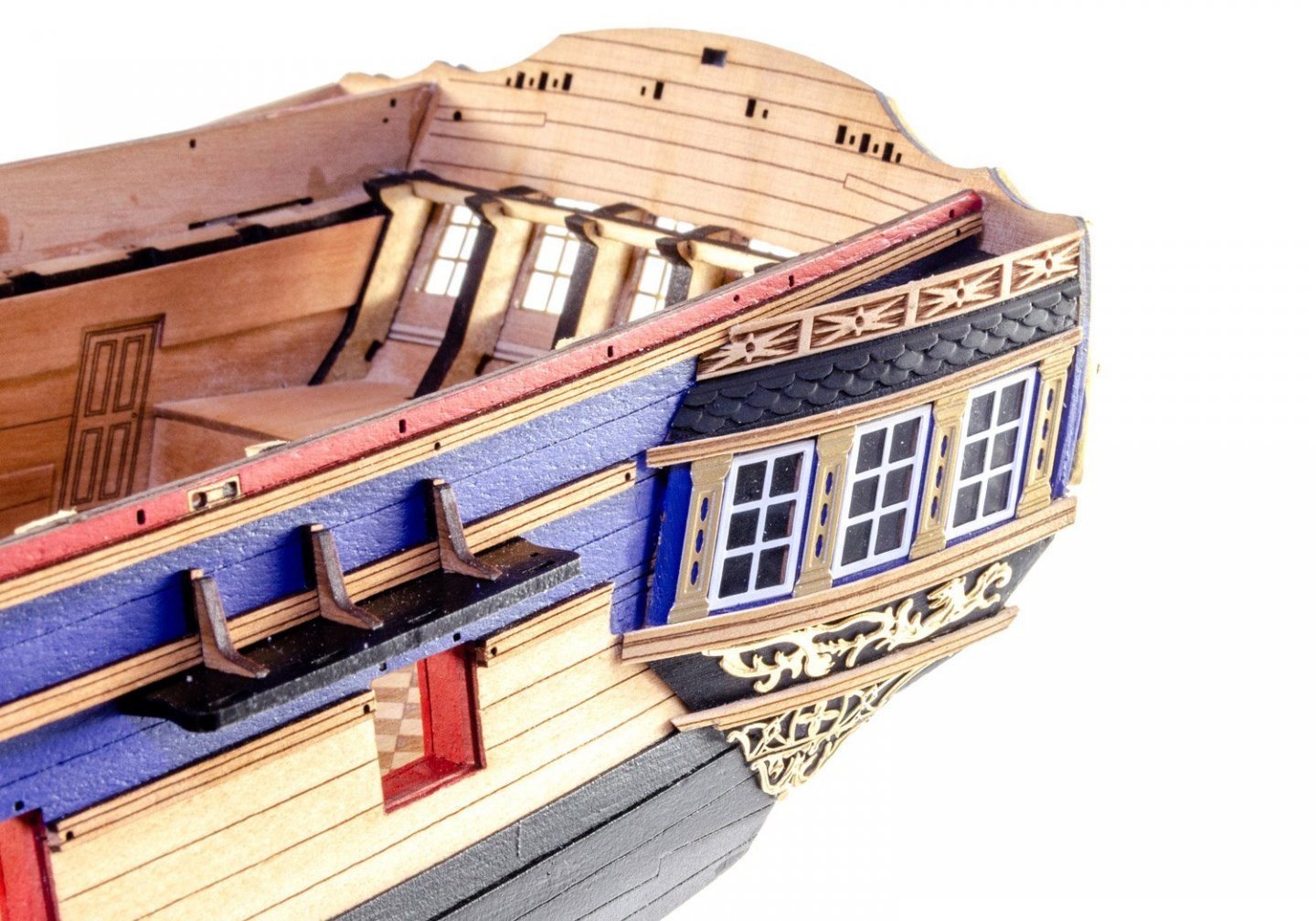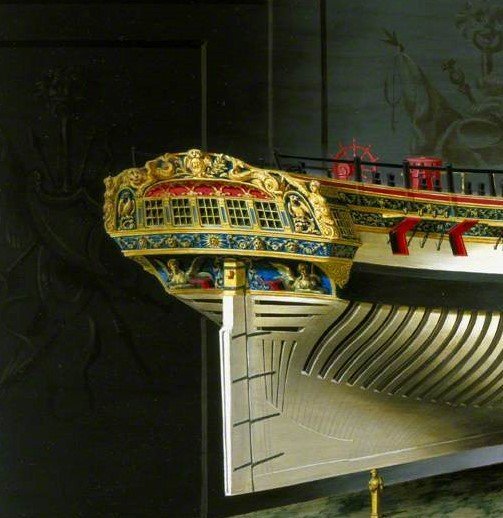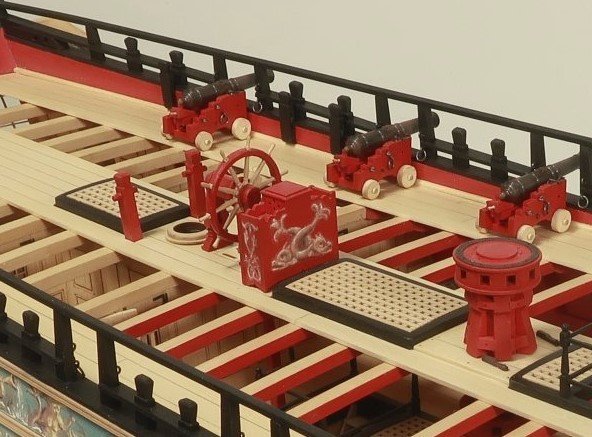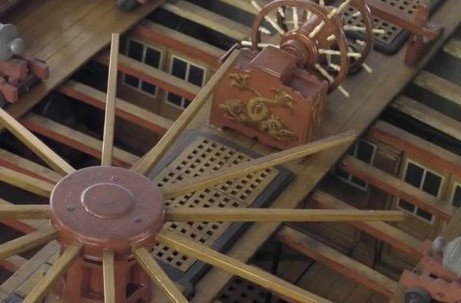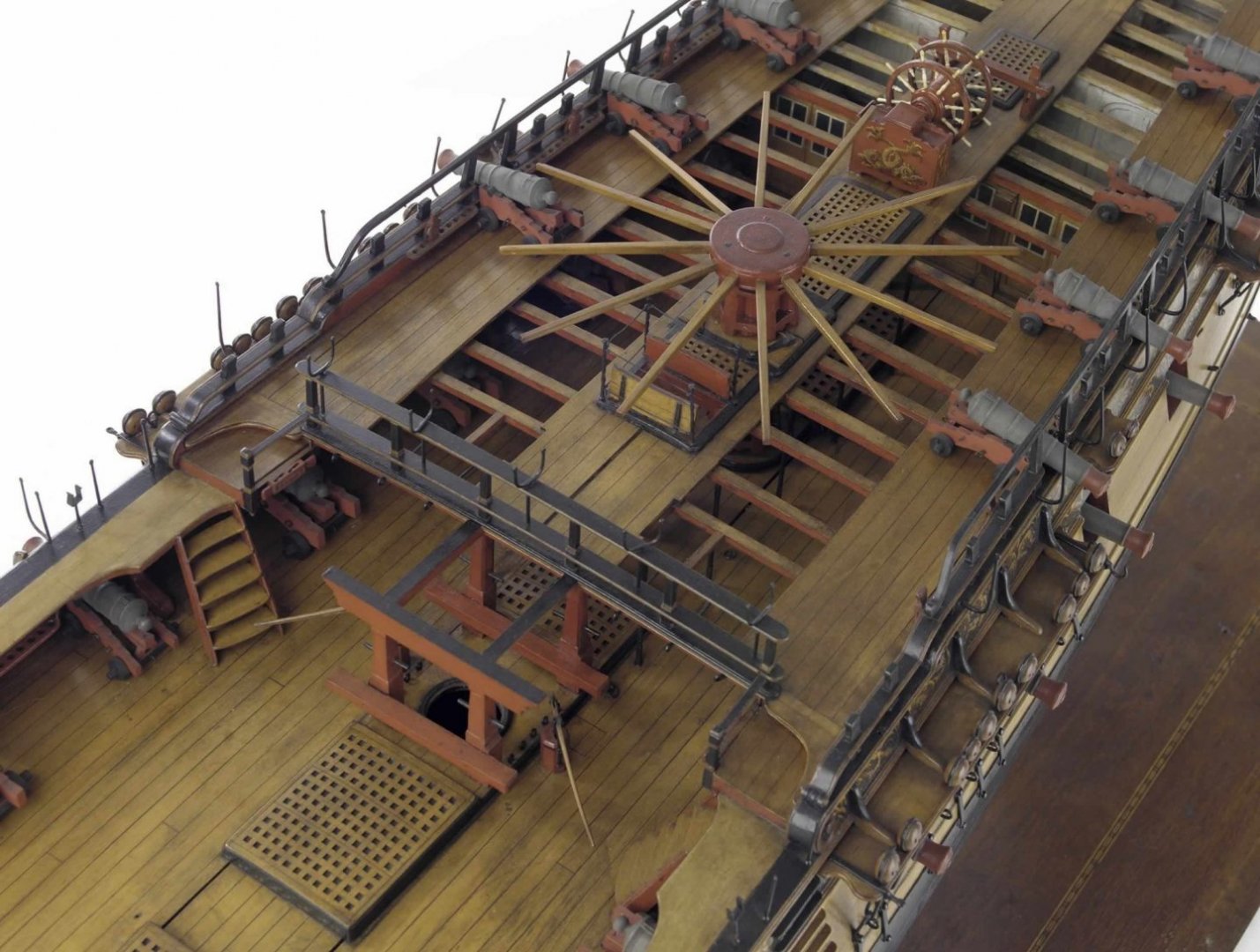-
Posts
4,564 -
Joined
-
Last visited
Content Type
Profiles
Forums
Gallery
Events
Everything posted by Blue Ensign
-
Hi Derek I've scoured my reference books looking for a comparable arrangement and the nearest thing I came across was this painting by John Cleveley the elder, of a sloop dated around 1740. As you can see the ratlines do span the larger distances between 3 and 4 and 4 and 5 I think I would have to try them across all shrouds and make an aesthetic decision based on how it looked to my eye. One other thought, the space on the Duchess aftermost shrouds is quite narrow, and ratlines purely between those two shrouds may look very cramped. Regards, B.E.
- 345 replies
-
- Duchess Of Kingston
- Vanguard Models
-
(and 1 more)
Tagged with:
-
I wonder if Chris can throw any light on the arrangement which does look a little out of the norm for ratlines to cross that span. What is the scale distance between the shrouds either side of the gun port? B.E.
- 345 replies
-
- Duchess Of Kingston
- Vanguard Models
-
(and 1 more)
Tagged with:
-
Ha, Ha, Derek, you jest of course, remember I've seen your stuff. B.E.
- 855 replies
-
- Sphinx
- Vanguard Models
-
(and 1 more)
Tagged with:
-
Thank you Ron, The macro is a useful tool to address issues of finish, but I don't let it enslave me, therein lies madness. B.E.
- 855 replies
-
- Sphinx
- Vanguard Models
-
(and 1 more)
Tagged with:
-
Post One Hundred and Twenty-eight Taffarel Capping rail. The kit Taffarel is a three piece lamination which is difficult to mask, and should properly have a capping. On Pegasus I made a capping rail using Evergreen styrene strip which is easy to mould to the shaped top, and the medium is not an issue as the rail was to be painted. With Sphinx I used 0.8mm x 3mm Pear strip, well soaked, and clamped into place on a spare Taffarel piece to form the shape. 7159 Ca was used to glue the capping progressively along the Taffarel top. 7160 It took a while to get the ca to hold, and there was the inevitable need for micro filling and re-touching of the facia. 7169 I originally painted the rail Ochre brown, which looks brighter here than it actually is. 7170 … but against the red of the inboard Taffarel it didn’t look good, a bit like raspberries and custard. 7180 I changed the colour to black to match the other cappings. 7185 A lot of re-touching the paintwork followed, followed by more re-touching, followed by more… you get the idea. 7186 There are many opportunities to go off-line when painting the fine detail, the cold eye of the macro lens reveals all. I work towards the point that when wearing my specs from a viewing distance of around 10” nothing untoward catches my eye. 7182 Of course I am a founder member of the Blind man on a galloping horse school of model painting, so others may see things hidden to me. 7176(2) Moving onto the Channels. B.E. 04/06/2022
- 855 replies
-
- Sphinx
- Vanguard Models
-
(and 1 more)
Tagged with:
-
Post One hundred and twenty-seven Quarter Gallery Decorative roof rail. Before I move onto the channels I have decided to attend to the Quarter gallery roof rail, described in the kit blurb as the Upper Fretwork. Before any fitting work or even removal from the fret the piece is painted to match the colour scheme. I was slightly puzzled by the fit of these decorative pieces; one end has a wider section than the other, which I took to be the forward end. I note on the prototype build photos that the forward end has been trimmed to sit below the decorative upper rail. 319 Beautifully fitted but I didn’t think the cut-away arrangement looked quite right, and it didn’t match the arrangement on the plan. To address this, a small section of the decorative upper rail on the hull was removed. The roof rail needs to be curved to match the contour of the Gallery roof. 7134(2) To this end I used the spare mdf gallery blanks as formers to heat bend the pieces. A piece of fret was used to provide a support against the tafferal, and a metal support pin was used centrally to keep the rail in line with the roof contour. The forward end of the roof rail fayed into the space in the decorative rail. The bottom of the finishing piece was bevelled on the underside to give a slight inward inclination. With all the trial fitting and handling the pieces required repainting before fitting. As with many things during a build one side fits easily, the other a struggle. 7154 7139(2) 7143(2) Fitting the Starboard roof rail went without issue, but a problem was quickly revealed on the Port side. The problem being that my shaping of the roof top was too severe at the forward end resulting in the rail not sitting correctly atop the shingle roof line. Incidentally I was pleased to see that Chris has replaced the brass etch tiles on his new Indy kit with laser cut card, I wish I had had them on Sphinx. The tiles were removed and the roof line adjusted using filler to build it up. Annoying to have had to back-track but the repair will be hidden by the shingles. 7137 This photo shows the filler build -up, the support pin, and Tafferal support. 7147(2) Port side restored. I'm not entirely sure that I like the solid look of the roof rail, nor particularly the results of my efforts. I think an open fret rail would have been a better fit for this decorative item. I'll leave it a while but I may have to re-visit the whole roof set -up. 7145 There is still some work to do on the stern, a capping rail to be fashioned, and one or two bits and pieces to tidy up. B.E. 02/05/2022
- 855 replies
-
- Sphinx
- Vanguard Models
-
(and 1 more)
Tagged with:
-
Looking good Glenn, and by fitting the first few Ratlines at intervals certainly helps to counter pulling the shrouds out of line, it's the method I use for 'Rattlin' down. B.E.
- 476 replies
-
- sphinx
- vanguard models
-
(and 1 more)
Tagged with:
-
Post One hundred and twenty-six A final push on the Gun wharf Before I started, an annoying set back. In a moment of carelessness faffing around with the model for my last photo shoot I dislodged the rudder breaking off three gudgeons from the stern post. On reflection perhaps I shouldn’t have questioned those boom rings in my last post, some sea devil has created a need for them.😕 Even manoeuvring a model the size of Sphinx has its dangers, God knows how I would get on with a beast like Indy on my 24” deep work bench. I have form for concentrating so hard on the job in hand that I swing the model around without checking the proximity of obstacles, usually the wall.🙄 Re-hanging a rudder is a pleasure I could have done without. I knuckle down to assembly of the remaining guns. There seems an awful lot of char removal in eight guns but it has to be done. 7112 The barrels are washed and sprayed with fixative after which weathering powders are applied and brushed off. 7114(2) For the last time with Sphinx I set up my production line. I find I have run out of Amati fine copper eyelets that I use for the loops, and in combination with Amati 2mm brass rings for the breeching ring bolts. I only have sufficient makings to complete two guns but at least these can be used to fit beneath the Gangway which will allow me to complete the Ladders down to the Upper deck. The remaining six guns will have to wait until fresh supplies arrive from CMB. 7122 I amuse myself assembling the ladders – nicely shaped but a pain in the Orlop to put together. 7121 7124 I may well include cut off masts. But they won’t look like these place holders. Time to look at the Channels I think. B.E. 01/6/022
- 855 replies
-
- Sphinx
- Vanguard Models
-
(and 1 more)
Tagged with:
-
Chris has such a knack of producing pretty models, and you have built a fine example that surely must encourage sales. Beautiful work as always Rusty.👍 B.E.
- 201 replies
-
- Duchess of Kingston
- Vanguard Models
-
(and 1 more)
Tagged with:
-
I do love to see beautiful headworks befitting an amazing model, your attention to detail and effort to achieve the best it can be mark you out as someone special in the world of model ship building. Thank you Chuck. B.E.
- 1,784 replies
-
- winchelsea
- Syren Ship Model Company
-
(and 1 more)
Tagged with:
-
Hi Glenn, re the Mizen Catharpins: Lees mentions use of these on the Mizen, but they are not included on the rigging plan for Pandora (AotS) nor do they appear in Steel's rigging tables for vessels rated 20 -24 guns. If you decide to keep them consideration needs to be given how they may impact when it comes to fitting and rigging the Gaff. B.E.
- 476 replies
-
- sphinx
- vanguard models
-
(and 1 more)
Tagged with:
-
What you say is a standard approach OC what I'm saying is gentle handling is required with these parts, any breakages can create problems with the built in camber. B.E.
- 505 replies
-
- vanguard models
- Sphinx
-
(and 1 more)
Tagged with:
-
Coming along nicely Mark, Be careful with the deck beams when trial fitting and cleaning, the slots for the carlings are a weak point, as are the slots on the ends to fit along the bulwarks. Slow and steady is the way to go. B.E.
- 505 replies
-
- vanguard models
- Sphinx
-
(and 1 more)
Tagged with:
-
Looking good Peter, very nice work. Love the second shot in the sequence, did you know there appears to be a hobgoblin lurking at the head.😉 B.E.
- 366 replies
-
- bellerophon
- victory models
-
(and 2 more)
Tagged with:
-
Thank you Derek, Bob, and Ron, and for those who follow and ‘like’ my build. @ Derek - You’re very kind, but I’m not sure where I would put such a beast as ‘Indy’ I do have Chuck’s Medway Long boat beneath my bench, ½” scale for my tired old eyes, and beautiful Boxwood timber. Regards, B.E.
- 855 replies
-
- Sphinx
- Vanguard Models
-
(and 1 more)
Tagged with:
-
Duchess is looking wonderful, Derek, I do love the look of Boxwood, I much prefer it to Pear. An impressive workspace you have there, makes mine look cramped by comparison, and as for David's (desalgu) Mrs W happened to spot it and I'm now under the cosh to tidy things up. (Great looking aircraft by the way) Cheers, B.E.
- 345 replies
-
- Duchess Of Kingston
- Vanguard Models
-
(and 1 more)
Tagged with:
-
Thank you Nils. Post One Hundred and Twenty-five Quarterdeck rails A slight dilemma The kit shows six extended timberheads used to support the fife main rails along the Quarterdeck; this accords with the Admiralty drawings dated 1775. The Marshall painting however shows three of those supports (the 3rd,4th ,& 5th) looking suspiciously like swivel gun mounts. The rounded tops extending above the rails and the faint lines of the posts can be made out. I was surprised by the absence of swivel posts when I first saw the kit, they were almost de rigueur on ships of this period. After consideration I decided that discretion is the better part of kit bashing, and will follow the Adm plan. Firstly the timberheads. These are all position specific so not getting them mixed up during sanding and shaping is important. Working from aft I removed each pair sequentially and cleaned and fitted them before moving onto the next. The rail (Fife / Rough-tree/ Quarter. All names given to the rather elegant rail that runs along the bulwarks from stern to the break of the Quarter deck. One of the things I like about this kit is the fineness of the Quarter rails. No re-making as I had to do with the over-sized rails on Pegasus. These ones are a three piece lamination, but are long and delicate items that require careful handling. I gave them only a minimal sanding as they are to be painted. 7085 These shots show the Quarter rail just resting on the supports, a testament to the accuracy of the slot cutting on the underside. One of the kit fittings along the gunwale is PE151 described as a boom ring, this sits just forward of the Main Brace sheave. This features on the contemporary Amazon model and also on the Pandora drawings. However, in those vessels the Main Brace sheave is placed below the gunwale, with the ring atop. I’m not entirely sure what these rings were for but I’ll take a punt that they were used to pass a horizontal boom through either side to attach emergency steering gear to. They do not appear on the Sphinx Adm. plans or the Marshall painting, so I’ll omit them, but for those not overly concerned with such minutiae they do add a little more interest to the model, particularly if you wish to jury rig the rudder. Another major milestone along the way, there is not much left to do on the Quarterdeck. 7094 7089 7091 7104 7105 7106(2) Sphinx is such a pretty little Frigate, a good choice for Chris to have added to his line-up. 7095(2) 7101(2) With the rails in place Sphinx is really starting to look to be nearing completion, but I reckon I have a few months work yet to enjoy. I now have eight nine-pounders to make-up to complete the ordnance, not one of my favourite jobs. Cheers, B.E. 28/05/2022
- 855 replies
-
- Sphinx
- Vanguard Models
-
(and 1 more)
Tagged with:
-
Post One Hundred and Twenty-four Pumps These are the Elm tree pumps either side of the Mainmast One of the errors on many kit models is that the pumps are shown sitting vertically on the deck. In practice the long tubes of the pump were inclined from the deck down to the bilge near the keel. The kit version is made using Walnut dowel but this feature can be enhanced for authenticity by using square stock and making the shape octagonal which was the usual form. 7062(2) The kit does provide a very nice etched pump mechanism to sit atop the tube, notwithstanding that it looks more 19th century than 18th to my eye. The design has been taken from drawings in the AotS book on Pandora, which is the only one in the series that seem to have this style. I did find a reference to brakes being fitted with quadrants in 1789, but I have not seen such a type represented on contemporary models. 007 3471 The simpler form of pump as fitted to Pegasus and Alert, above, is I think more period appropriate. Still the kit version is too pretty to discard, that is unless the pedant in me overwhelms the appeal to my eye. This is a fiddly item to assemble, certainly with fat slightly arthritic fingers. Ca is used to assemble the frame which has implications for the blackening process. Thorough cleaning is essential prior to the chemical blackening of the mechanism to remove all traces of ca. The first blackening reveals any residual ca stains which can then be addressed. 7064(2) The detail is impressive, Chris has to be congratulated on producing this, look at the teeth on the ratchet, this is tiny stuff. 7077(2) The octagonal shape of the pump can be seen here. A final touch is to add the discharge pipe at the lower end of the pump and include a representation of the iron hoops around the top and bottom. 7081(2) 7078 It is a pity that such nice little items will mostly be hidden, even on a Navy board style model such as mine. B.E. 26/05/22
- 855 replies
-
- Sphinx
- Vanguard Models
-
(and 1 more)
Tagged with:
-
Thank you James, bug, and Rusty, and for the 'likes' @ Chris - do stop it - you torment me Sir,😉 Post One Hundred and Twenty-three ‘Elf n safety considerations – Guard rails The ladderway stanchions are represented by brass etched posts with an eye, thro’ which line is threaded. For this particular function the kit style is a bit of a simplification so I look for alternatives. I can just about make out what appear to be iron stanchions around the Q’deck ladderway on the Marshall Sphinx painting, so iron stanchions it will be. The stanchions do need to be removeable as particularly with the Quarterdeck ladderway operation of the Upper Capstan is a consideration. I note on the Amazon model that hinged covers for the hatchway are also in place, presumably to allow for foot passage when working the capstan, as well as weather considerations. For the stanchions I am going to use the same system I adopted for Pegasus, which was based on the detail in the fffm Vol 11. The makings involve having donor stanchions, the ones I use are 0.9mm ø with a 1.3mm finial. For the rings 0.3mm eyelets, (Caldercraft) are used, and 0.5mm ø brass rod for the rails. A spot of silver soldering is required to bring it all together. Silver solder paste in two melt points 690º and 671º is required. Full details of the procedure can be found in my Pegasus log (page 4 – post 91) 002 The biggest part of silver soldering is setting up the parts. 6989(2) The second is the cleaning up afterwards. 7018 Trial fitting the rails before blackening. 7050 Meanwhile on the Upper deck Capt. Grimm is no doubt thinking, ‘What lubberly idiot designed the main ladderway access to open onto the Main hatchway, between the stanchions for the pump handles, which then have to be negotiated for access to the Upper deck.’ 7044 I understand that he did tentatively raise the issue with the Dockyard Superintendent, but was given short shrift, who was he to question the work of the renowned Naval Architect Mr John Williams. It is perhaps not unsurprising that Capt. Grimm does not appear on the list of commissioned Captains of Sphinx, but at least he avoided the ignominy of being taken by the French. Lets hope a general ‘all hands on deck’ isn’t signalled at the same time an urgent need to man the pumps is required. 7047 7040 7045 7033 These are fiddly little beggars to fit but best done before the Quarterdeck rails are fitted. 7057(2) B.E. 24/05/2022
- 855 replies
-
- Sphinx
- Vanguard Models
-
(and 1 more)
Tagged with:
-
Post One Hundred and Twenty-two Quarterdeck fittings – The Binnacle These are not often shown on contemporary models, the Amazon model is a fairly rare exception. I am undecided at present whether I will include it, but that’s no reason not to make one up. The kit offering is quite a detailed construction with brass etched representations of the compass within the glazed compartments, and complete with a fine brass chimney. The style is of the type as fitted to HMS Victory and indicated in the drawings of the Pandora AotS book. But… there’s always a but, to my eye the Victory style doesn’t sit well on Sphinx, it seems somehow out of period, and I think a simpler affair, similar to that fitted on Pegasus is called for. I was tempted by the more elaborate version shown on the Amazon model and reproduced on Chuck’s Winnie model (above). It does look wonderful, but again I thought it a little too fancy for a sixth rate. 115 Trincomalee Binnacle. The versions on Victory and also Trincomalee are of the same type with glazing both sides of the binnacle cabinet. Amazon model Binnacle. The contemporary Amazon model Binnacle only has lights facing the Helmsman. I had a look at the French version shown in Boudroit's epic tome The Seventy-four gun ship. Here the binnacle cabinet is fully enclosed using vertical sliding doors and with only an angled and lidded viewing compartment for the Helmsman. For my purposes I think the provided kit item can still be used but toned down to a simpler form. A tale of two Binnacles I seem to have ended up with two Binnacle sets so I can have two bites at the cherry. Version one. The kit item has inset panels defined by char which present a problem if the the Binnacle is to be painted. It is the very devil to clean off the char and smooth these small square panels, less necessary if the item is to be simply varnished. 6939 6953 Here I blocked off the the open lights of the fore side using small square infills, as with the central light on the aft side. The chimney was dispensed with and replaced by a wooden vent atop the Binnacle. When I exposed the completed item to the harsh macro eye, to say I was displeased with my efforts is a gross understatement. It is far too destressing for public view, and the above photos are as close as I dare let the camera get. Version one will not stand. Version Two 6970 On this version I chose to replace the fore side of the Binnacle with a plain wooden board, without the lights, and reverse the other parts to have the panel decoration inside. 6972 The central (light) compartment on the aft side was converted into a solid door. The central light compartment is closed from view to the Helmsman to avoid glare which may compromise night vision. 6978 This option made painting a much easier prospect and improves the chances of getting a better finish. 6981 6976 The final task is to apply a suitable motif design to the forward face. 6985 I trialled several but settled on the Amazon design as created by Chuck for his Winchelsea. 6986 Needs a little fettlin’ around the edges to blend in. After a weekend working on the Binnacle I’m still not sure whether to include it on the model, it does mask the forward view of the wheel. Moving on…. B.E. 23/05/2022
- 855 replies
-
- Sphinx
- Vanguard Models
-
(and 1 more)
Tagged with:
-
hollowneck said Note: the tiny P/E oarlocks are reversed from the photos shown in the instruction manual; I believe these were intended to be mounted in the manner I've shown here, two pieces, facing inward to form a metal "U" in which the oar would rest. The brass P/E pieces to form these are a quite clever way to depict these miniscule details, and crucial to present an accurate representation of a ship's boat. "The Devil's in the details, right Captain 'P'"? Hi Ron, I don't think you are correct in your assumption. The small extensions are support pieces (usually of wood) to the pins that fit thro' the small support wedges. Slightly different to 'U' shaped oarlocks of the later period. Still, yours is a hybrid, but I wouldn't want other readers to think that was the norm. Regards, B.E.
- 542 replies
-
- Sphinx
- Vanguard Models
-
(and 3 more)
Tagged with:
-
Your hybrid turned out very nicely Ron, I think you’re right to only show one boat on the skids, such a shame to hide all that upper deck detail. B.E.
- 542 replies
-
- Sphinx
- Vanguard Models
-
(and 3 more)
Tagged with:
-
Post One Hundred and Twenty-one Quarterdeck fittings I start with the ships wheel I quite like the look of the wheel, even given its flat etched profile. 6928 I was torn between a white or Red colour scheme, I liked both, but settled on Red in the end because that is the colour indicated on the Marshall painting, and there is no other white paint on the model. To prepare the Brass etched wheel I chemically blackened it to provide some bite for the paint. 6926 After initial thinned coats were applied, undiluted paint was used to beef up the spoke profile. The spokes outside of the rim were painted using Ochre Brown. Standards 6916 I did note a slight misalignment of the engraved panel work on the standards, seemed to be off centre. I don’t know if this a poor example on my kit, but hopefully it won’t be too obvious with the Binnacle afore it and the Mizen behind. Before securing the forward standard I added a thin sleeve between the standard and the wheel, otherwise the wheel would bind against the standard. At the point the Upper deck was fitted, way back, I had secured the tiller rope so that they may be rigged should I decide to do so. Two separate lines were placed below the Upper deck, one fixed on the Port side, the other running on the Starboard side, and temporarily tied off. With the Wheel assembly in place rigging the tiller lines can be done. 6919 Starting on the forward Port side an odd number of turns were taken around the drum I chose five as being appropriate, a nail being secured thro’ the centre turn into the top of the drum. It is a fallacy that the rope runs were fully expended along the length of the drum. With the turns completed the Port line is spliced to the Starboard line and gently teased thro’ the deck slots. 6915 The running end of the Starboard line which emerges thro’ the aft ladderway of the Upper deck is then used to pull the now joined lines taut. This is the tricky part hoping that the spliced line doesn’t part below decks. A spot of glue is applied to the line where it passes thro’ the deck in the Coach. 6911 Before passing thro’ the Quarterdeck the lines pass thro’ a device called a Sliding foot which for model purposes was fitted on the lines before they passed around the drum. There is some work left do on these but they needed to be fitted at this point. 6924 6925 Adding the wheel makes a big difference to the look of the model, and I am pleased that this is a good match to the Marshall painting. 6931(2) 6935(2) 6936(2) These photos mark the tenth month of this build, and there’s a fair way to go yet. I will next look at the Binnacle. B.E. 20/05/2022
- 855 replies
-
- Sphinx
- Vanguard Models
-
(and 1 more)
Tagged with:
-
Post One Hundred and Twenty Quarterdeck Breast rail This is a nicely designed assembly with parts that slot together with a good fit. The main job is the finishing of the Balusters which the blurb indicates need shaping to form a roundness. No easy task this as the area to work on is very small, and the rectangular profile of the Balusters doesn’t lend itself for uniform rounding. In retrospect I think it may be better to clean up the Baluster and leave it as is rather than try to apply a round to the bulbous section. 6868(2) Even char removal has risks of changing the profile so a very light touch is required I have decided to leave the Balusters bright as indicated on the Marshall painting, but the two lower rails will be blackened to match the bulwark rails. 6855 The middle rail I heat treated to match the camber and used line to secure the ends until the glue set. 6860 I don’t think I will be fitting the hammock cranes to the rail. I wasn’t too keen the way the Balusters turned out and I was tempted to rip them out but that would probably have wrecked the rails as well. The saving grace is that other than at macro level they don’t really impact on the eye. (well my eyes anyway.) 6871 Capt. Grim tries out the rail for scale, undecided whether to paint the rail or leave bright, but I can defer that decision until the Quarterdeck rails are in place. The kit provided Newel posts were replaced with ones that better suited the Gangway modification. They were made from some 2x2mm Pear square stock. 6883 The Newel posts were on and off the model a dozen times as I kept perceiving one or the other was out of plumb. Deffo out of plumb in this shot. 6882 Eventually they satisfied my eye and the rail could be fitted. 6892 The final part is the delicate scrolled Handrail. 6890 Very careful handling is required with these pieces during char cleaning, but Chris has provided two spares should mishaps occur. I note on the Amazon model that Cavel blocks have been fitted forward of the Quarterdeck on the inboard edges of the Gangway step. 6894 I decided to add these to Sphinx. I’ll leave this area for now and and look at the Binnacle and ships wheel. B.E. 18/05/2022
- 855 replies
-
- Sphinx
- Vanguard Models
-
(and 1 more)
Tagged with:
About us
Modelshipworld - Advancing Ship Modeling through Research
SSL Secured
Your security is important for us so this Website is SSL-Secured
NRG Mailing Address
Nautical Research Guild
237 South Lincoln Street
Westmont IL, 60559-1917
Model Ship World ® and the MSW logo are Registered Trademarks, and belong to the Nautical Research Guild (United States Patent and Trademark Office: No. 6,929,264 & No. 6,929,274, registered Dec. 20, 2022)
Helpful Links
About the NRG
If you enjoy building ship models that are historically accurate as well as beautiful, then The Nautical Research Guild (NRG) is just right for you.
The Guild is a non-profit educational organization whose mission is to “Advance Ship Modeling Through Research”. We provide support to our members in their efforts to raise the quality of their model ships.
The Nautical Research Guild has published our world-renowned quarterly magazine, The Nautical Research Journal, since 1955. The pages of the Journal are full of articles by accomplished ship modelers who show you how they create those exquisite details on their models, and by maritime historians who show you the correct details to build. The Journal is available in both print and digital editions. Go to the NRG web site (www.thenrg.org) to download a complimentary digital copy of the Journal. The NRG also publishes plan sets, books and compilations of back issues of the Journal and the former Ships in Scale and Model Ship Builder magazines.


